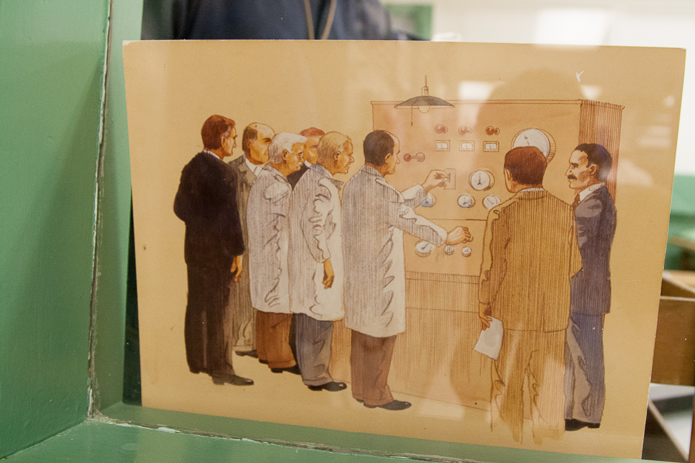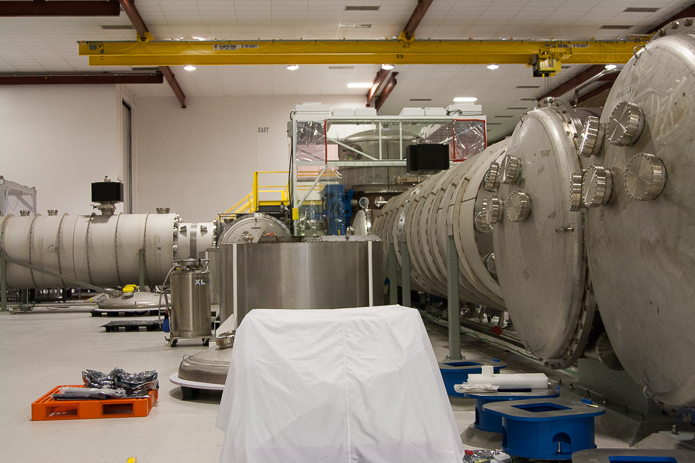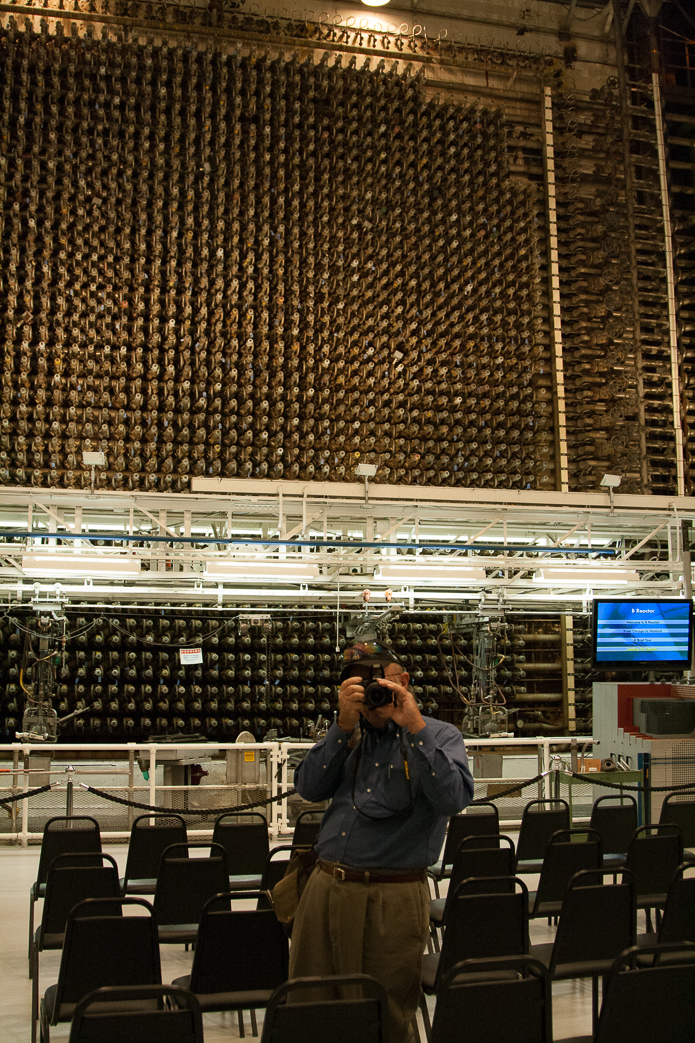
Sketch of Enrico Fermi and his colleagues at Hanford (c. 1944), Enrico Fermi’s Office, Hanford B Reactor Museum Photo: © 2012 Olivia Fermi
I’m thinking about the different challenges you confront when sometimes you know something isn’t right, but yet you still do it.
I’m thinking about history, and how society and science influence each other. What we do today will influence the future.
– Neutron Trail workshop student participants, October 2012, Richland, WA
In Southeastern Washington at the confluence of three rivers, the Yakima, Snake, and Columbia, is the traditional home of the Wanapum, Yakama and Walla Walla native peoples. The land and the rivers gave these peoples a home and sustenance. Later, they were almost entirely displaced by a wave of European settlers who established towns there, including Richland, now one of the Tri–Cities. Another wave of displacement came in 1943 when the US military evicted Richland area citizens to build the Hanford Nuclear Site, a top secret plutonium refining facility (now decommissioned), and the town of Hanford (which no longer exists), to house its workers.
Today Hanford is the site of the largest environmental cleanup project in the world.
Technological progress cannot be expected to solve problems of the human spirit.
– Neutron Trail workshop senior participant, October 2012, Richland, WA
In October of 2012 I was invited to Richland to give a talk and two Neutron Trail workshops. My visit was sponsored by LIGO, the astrophysics lab housed at Hanford; and paid for by a National Science Foundation grant to promote community involvement with science and the arts, with additional support from The Graduate Center of City University of New York Science and Arts Program.
Along with giving my presentations, I toured LIGO and the Hanford B Reactor Museum, as well as meeting with some members of Hanford Watch, a community panel, monitoring and giving input to the Hanford site clean–up. All these activities together made it a quintessential Neutron Trail stop for me. The trip began before I ever arrived as I researched this place I had been waiting to visit for so long. I learned more about the massive scope of the Hanford site (586 sq miles or 1,518 km) and that B Reactor was the first commercial nuclear reactor ever built. B Reactor supplied the weapons grade plutonium for the Trinity test bomb and the Nagasaki bomb; along with the other reactors built at Hanford it supplied plutonium for all the atomic bombs the US produced during the Cold War.
Reading up on current efforts to find safe storage for 56 million gallons of toxic waste at Hanford was enough to make my stomach churn. Leaving aside arguments about whether it was in the past wise to stockpile so many atomic weapons, now, today in a globalized world, it certainly is not right. And that is, in a sense, the crux of what is so difficult about Hanford.
… scientific advances in basic understanding have sooner or later led to technical and industrial applications that have revolutionized our way of life…What is less certain… is that man will soon grow sufficiently adult to make good use of the powers that he acquires over nature. — Enrico Fermi, The Future of Nuclear Physics, unpublished address, Rochester, NY, January 10, 1953
On the Neutron Trail, I often meet folks who express tremendous pride about the achievements of the Manhattan Project. In the historical context of World War II realities, their sentiments make sense to me. I also meet folks who have been directly and indirectly affected by the testing and dropping of atomic bombs, radioactive fallout and toxic nuclear waste from atomic bomb making facilities. Nuclear weapons and nuclear weapons production facilities cause suffering. There’s a disconnect here. Are we able to feel proud of past achievements and at the same time feel sorrow at the effects atomic bombs have had on human life and the environment? Or do these realities somehow exclude each other?
My own answer to this dilemma is to investigate and immerse myself into these disparate views, whether or not they are natural to me. By immersing myself in them, I don’t just understand them, I end up evaluating relative truth. And that expands my compassion and helps me to grow up.
Continuing my pre–trip researches, I was surprised to learn my grandfather Enrico Fermi had an office inside the Hanford B Reactor building. I didn’t know he’d spent that much time there and had often wondered what it had actually entailed to be the 2ic under Robert Oppenheimer. You can see Enrico’s office here on the virtual tour of Hanford B Reactor: use your mouse to look around there or any of the other spaces in the building. I also learned my grandfather ceremonially pulled the control rods to launch Hanford B into production. That was September 1944 when the project to build an atomic bomb to stop Hitler’s aggressions was in full swing. Perhaps they gave him the job because two years earlier on December 2, 1942, Enrico had ordered the control rods pulled on a small nuclear test pile at the University of Chicago. His test reactor proved humanity really could unleash the energy of the atom.

Inside LIGO Laser Interferometer Gravitational-Wave Observatory, a contemporary science experiment housed on the Hanford Site, looking for gravitational waves. The two pipes you see at 90 degree angles each extend outdoors for 2.5 miles (4 km). Photo: © 2012 Olivia Fermi.
It’s a pleasant six hour drive from Vancouver to the Tri–Cities, moving from coastal terrain, through the Cascades and then down into the flat of the Columbia River Basin plateau. I arrived in the afternoon, in time for a tour of LIGO, whose work it is to look for hypothesized gravity waves. It’s a deceptively simple science experiment requiring incredibly fine precision.
It was a good challenge for me to get my thinking in the moment of the workshop – just because as an adult you have to take time to push away current thinking to be reflective.
– Neutron Trail workshop teacher participant, October 2012, Richland, WA
The next morning I was treated to a royal tour of the now retired (and not radioactive) Hanford B Reactor. The atmosphere on the bus was infectious. All the volunteer docents for the B Reactor tours accompanied me, filling the tour bus with excited energy. The docents are typically retired engineers and physicists, many of them having also worked on the Hanford cleanup. In fact, if I’d come a few years earlier, I might have met scientists who worked at Hanford during the Manhattan Project when my grandfather was there. For me, who is sensitive to different worldviews, it was almost surreal. The docents’ enthusiasm for Fermi, for the achievements of Hanford during the Manhattan Project and the retro time capsule feeling inside B Reactor contrasted with what I knew was outside but wouldn’t tour — the cleanup of 56 million gallons of toxic nuclear waste, much of it in old, some now leaking, single walled storage tanks. I knew the vitrification project to turn the waste into relatively inert glass logs was years behind due to cost overruns, mismanagement and technical problems. In fact, I wondered if the technical problems at Hanford were solvable, with today’s know–how. Meanwhile, the docents pointed out the marvel of B Reactor’s complex success in an era of slide rules and pencils. I didn’t know whether to giggle or to cry out.
I enjoyed a sense of interconnectedness.
I enjoyed that we all got to talk together.
– Neutron Trail workshop student participants, October 2012, Richland, WA
That evening, with an enthusiastic crowd of about 200, I had another memorable experience and a delightful time delivering my talk. Since we were on Neutron Trail territory, I started off by posing some Neutron Trail questions to my audience. How does living in this particular place shape your life? How does living here affect your relationship to community? And how has your life here changed your view of the world?
I wove the story of my grandparents’ lives with the history of their time. In the talk I showed how we don’t view the world in the same way now as we did then and how our place in it continues to shift. My grandmother Laura who had primarily been a housewife until Enrico’s death, went on to become a successful author and an early pioneer in the environmental movement. My grandfather and the other Manhattan Project scientists were driven by the fear that Hitler would possibly create an atomic bomb. After the war, many of those scientists were at the forefront of warning and educating the public about the grave threat of nuclear proliferation. Now, over 60 years later some politicians and diplomats are coming around. Four prominent Cold War warriors, who were solidly behind the US policy of nuclear weapons stockpiling George Schultz, Henry Kissinger, Sam Nunn and William Perry, made a complete turn around. In 2007 together they called for a world free of nuclear weapons.
With images, I questioned the underlying worldviews that drive choices and showed how art can open a space to consider new ways of thinking about life, death, birth and security. I give these talks because people tell me how inspired they are hearing about my grandparents. Throughout, I did my best to highlight the exemplary ways my grandparents led their lives that can apply to any era: their integrity, dignity and individual genius for seeing and taking action on key issues — Enrico in physics and Laura for society.
Changing our place can change our view of everything.
– Neutron Trail workshop teacher participant, October 2012, Richland, WA
On my last day in Richland, I visited Delta High School in the morning, where I led the students with their teachers through a Neutron Trail workshop experience. We started with a large group discussion, seeded with questions from myself to the group and they to me. I was impressed by the students’ knowledge and appreciation of the history of their community, their place in it and what kind of future they might each be preparing for. Of particular interest was why Enrico had spoken so strongly against the development of the hydrogen bomb, but when President Truman decided to go ahead, he worked on it. There is no definitive answer to the question — Enrico left no record of his private thoughts. And so I turned the question around and asked them to consider how they might have acted in a situation where their own moral compass said to do one thing, but their loyalty to the group said to do another.
I’ll listen more – and talk less.
– Neutron Trail workshop senior participant, October 2012, Richland, WA
In the afternoon, I went to the CREHST Museum (now Hanford Reach Interpretive Center) to give a Neutron Trail workshop to retired engineers and docents as well as the museum’s director. Things got sparky beforehand when one of the retired scientists was touring me through the museum. I was curious to know the timeline of awareness about environmental impacts of activities at Hanford. For example, when did we learn about radiation spreading through the atmosphere? Effects on people and animals of various isotopes? Short term? Long term? The more he shared, the more questions I had, which seemed ultimately to be a source of irritation for him. I didn’t try to fix it. I began to work with the group assembled. Through discussion, in small groups and then reporting back in the whole group, I was happy to see willingness, if tentative, to share differing opinions and thoughts with each other about our use of nuclear technology then and now. I continued to gently encourage this without forcing.
The seniors group was lively and themes of community and interest in talking about Enrico were consistent with my experience in the morning with the high schooler’s. In one of the exercises, I asked participants to choose a time in history or the future and to create a human timeline in the room. I then invited each person to report out from their point in time, what they were witnessing. Afterwards, the gentleman who I had perhaps irritated before the workshop came up and thanked me warmly saying he really appreciated what I had sparked in the group. He said he found himself speaking in new ways with people he’d known for years, but rarely, if ever with whom he’d had this kind of conversation. Others gave similar feedback and I felt a very warm sense of gratification as we gave our farewells.
From start to finish the trip was full of wonderful connections and pregnant with unresolved issues. Now as I write, it’s October 2014. Citizens of Oregon and Washington, with Washington’s governor Jay Inslee in the forefront, have been battling for a proper cleanup at Hanford for years. A small step forward in the fight for accountability emerges as I do a Google search. The Environmental Protection Agency (EPA) is fining the Department of Energy (DOE) for repeatedly failing to meet agreed upon deadlines for toxic sludge removal at Hanford. Although this is very bad, it is a breakthrough of sorts.



 Twitter
Twitter
6 Responses to A Visit to Hanford